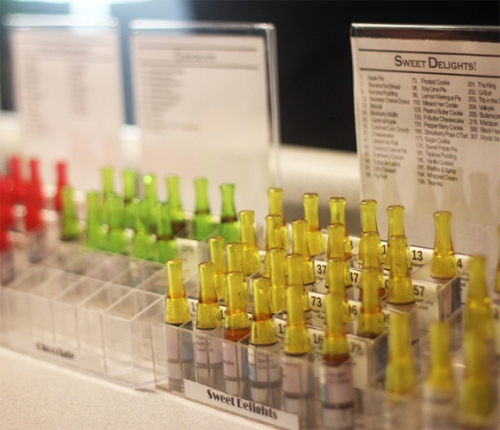
Cream of mushroom. Piña colada. A whole Thanksgiving dinner, from turkey to pie.
These are some of the flavors of e-cigarettes you can buy online or in stores. About half of U.S. smokers have tried e-cigarettes, according to research by UNC postdoc Jessica Pepper. But is that a bad thing? A good thing? Or both? “We have no long-term health data. We don’t know whether they help people quit smoking,” says Pepper, who so far has made her career studying e-cigarettes at the UNC Gillings School of Global Public Health.
In 2013, Pepper also found that pediatricians and nurse practitioners who treat adolescents aren’t well-informed about e-cigarettes. In fact, the number-one way health-care providers say they’ve learned about e-cigarettes is from their patients, Pepper says. “Clearly, we need to be doing some education. But we’re not entirely sure what to tell doctors to say.”
In the next few years, researchers at two UNC Tobacco Centers of Regulatory Science will help figure out just what to do about e-cigarettes. The Food and Drug Administration and the National Institutes of Health fund 14 of these centers around the United States to research tobacco-derived products. UNC is the only institution to have two separate centers—one to study the medical effects of tobacco products, and the other to figure out how to educate the public on the risks (and, perhaps, the benefits).
Fifty years after the U.S. government first warned the public that cigarettes cause lung cancer and bronchitis, almost one in five adults still say they smoke some days or every day, according to the Centers for Disease Control. Smoking is still the leading cause of preventable death both in the United States and around the world, Pepper says. Some researchers think e-cigarettes might be the thing that will turn the tide.
Since 2007, e-cigarettes have gone from almost nonexistent in the United States to being available in about one-third of convenience stores, according to a study by UNC PhD candidate Shyanika Rose. But most people order their e-cigarettes online. There are also brick-and-mortar stores, including at least two in Chapel Hill (see slideshow), devoted to selling the supplies. Vaping, as it’s called, is completely legal, and may be less harmful than smoking, researchers think.
“The most dangerous part about regular cigarettes is the combustion—the act of lighting something on fire,” Pepper explains. An e-cigarette doesn’t light anything on fire, so it doesn’t produce smoke. Instead of tobacco leaves, an e-cigarette is filled with tobacco-derived nicotine mixed with a flavoring and a type of alcohol (not the kind you drink) to keep it wet. You fill your battery-powered e-cig with this e-juice, which evaporates when the battery heats it up, producing a visible vapor instead of smoke. Vaping doesn’t produce a lingering, unpleasant odor like smoking does, although you might smell the flavoring if you’re standing near someone using an e-cigarette.
So far, each new study about the effects of e-cigarettes has told us something different, Pepper says. “You’ve got one study that says e-cigarettes have one-tenth to one five-hundredth of the amount of chemicals that are in cigarettes, but you’ve got a publication that came out a few weeks ago that says certain e-cigarettes, used in a certain kind of way, can produce as much formaldehyde as a regular cigarette.” The discrepancies, she says, probably have to do with the strength of the e-cigarette’s battery. The newest models can heat e-juice to higher temperatures, which can produce more harmful chemicals.
“Pretty much everyone, even the most conservative public-health people, agree that smokers will be best off if they quit—but if they can’t quit, they’re better off going to e-cigarettes,” says Pepper’s mentor, health-behavior researcher Kurt Ribisl, who heads one of the two UNC tobacco centers. In a 2013 study, researchers randomly assigned cigarette smokers to use either nicotine patches or e-cigarettes. At the end of the study, the rates of health problems in the two groups weren’t very different, Ribisl says. But that was just after six months. It will take years to determine the long-term effects of vaping.
In the UNC School of Medicine, physiologist Rob Tarran is particularly worried about flavorings in e-cigarettes. Flavorings were banned from regular cigarettes years ago because of their appeal to children, but that’s not the only problem with flavored tobacco products. “Remember popcorn lung?” Tarran asks. Diacetyl, a chemical used to give microwave popcorn its buttery taste, has made factory workers and at least one microwave-popcorn eater sick from inhaling the stuff. “Flavorings are safe if you ingest them,” Tarran says. “But no one knows what they do when they’re inhaled.”
He and UNC pediatrician Ilona Jaspers are testing some of those flavorings in the lab. Jaspers’ lab purchased 15 of the most popular e-cig flavorings. First, they grow lung cells in a lab dish. Then they expose the cells to different levels of the flavoring to see what exactly they do to lung cells. Meanwhile, chemist Gary Glish and his lab are meticulously analyzing the flavorings to identify each compound that vapers inhale.
Tarran’s also concerned about the effect of inhaling nicotine itself, whether through smoking or vaping. He leads one of the UNC tobacco centers in researching the effects not only of e-cigarettes, but also regular cigarettes, little cigars, and other tobacco products. Nicotine is known to be a carcinogen, Tarran says. He and Jaspers take samples of tissue to study from the nasal cavities of smokers at UNC Hospitals. They’ll also be testing samples from people who vape, to find out exactly what vaping does inside the body.
Seventy to eighty percent of people who use e-cigarettes are also tobacco users, and that’s one of the biggest problems with e-cigarettes, Pepper and Ribisl say. “Quitting smoking is very good for your health, but simply cutting back on smoking has very little benefit,” Pepper explains. “If you go from being a pack-a-day smoker to being a half-pack-a-day smoker and also using e-cigarettes, there’s not going to be much health benefit.”

“Some people who normally might have quit are now vaping during the day,” Ribisl points out. “Before e-cigarettes, those people might have quit because they’d have to go eight hours at work without a cigarette. But now they’re dual-using, and that’s bad for public health.”
That worries Tarran, who thinks that some e-cigarette users are getting a lot of nicotine. “A regular smoker takes maybe a dozen puffs on a cigarette,” he says. If you smoke a pack of 20, that’s about 240 puffs a day. “Our preliminary studies show that e-cigarette users take up to 900 puffs a day on e-cigarettes,” Tarran says. “The idea is that if you smoke a regular cigarette, you feel satisfied, you’re done. E-cigarettes may not give that same feeling of satisfaction.”
That may be the reason why many smokers who try e-cigarettes reject them altogether. Pepper did a study that showed that about 45 percent of people who try e-cigarettes for health reasons—for example, to help quit smoking—don’t stick with it. One of their biggest complaints, she says, is that e-cigarettes don’t deliver a nicotine fix as quickly as smoking does. But newer e-cigarette models are getting better at nicotine delivery, making it likely that more smokers will pick up vaping, Pepper says.
“Analysts predict that e-cigarettes are going to surpass regular cigarette sales in the next decade, and I think they’re right,” Ribisl says. “I think you’re going to see very, very few people smoking—probably fewer than 5 percent of the population 10 years from now.” In 2011, the average cost of a pack of cigarettes in the United States was $5.62 and rising, according to the Centers for Disease Control. E-cigarette manufacturers say that disposable e-cigarettes, which often cost between $6 and $11, are equivalent to two packs, making them cheaper than regular smoking. Refillable, rechargeable e-cigarettes cost more up front—often $40 to $60 or more for a starter kit—but after that, the e-juice equivalent of a pack of cigarettes can cost as low as $2 or $3.
Rising sales are part of the reason why the federal government should start regulating e-cigarettes, Ribisl says. “We did a study that had minors buy e-cigarettes off websites. We found that over 70 percent of the sites sell to kids. They aren’t verifying age properly,” Ribisl says. And those companies aren’t doing anything illegal: so far, there’s no law against the interstate sale of e-cigarettes to kids, the way there is for regular cigarettes. The FDA is still in the process of trying to gain regulatory authority over e-cigarettes.
Kurt Ribisl is a professor of health behavior in the UNC Gillings School of Global Public Health. Robert Tarran is an associate professor in the Department of Cell Biology and Physiology, and Ilona Jaspers is a professor in the Department of Microbiology and Immunology, both in the UNC School of Medicine. Gary Glish is a professor in the Department of Chemistry in the College of Arts and Sciences. The UNC Tobacco Centers of Regulatory Science are receiving about $40 million from 2013 to 2018 from the Food and Drug Administration and the National Institutes of Health, and are working on a variety of tobacco-related research projects.
Click here to see the full Endeavors article by Susan Hardy with additional pictures.




